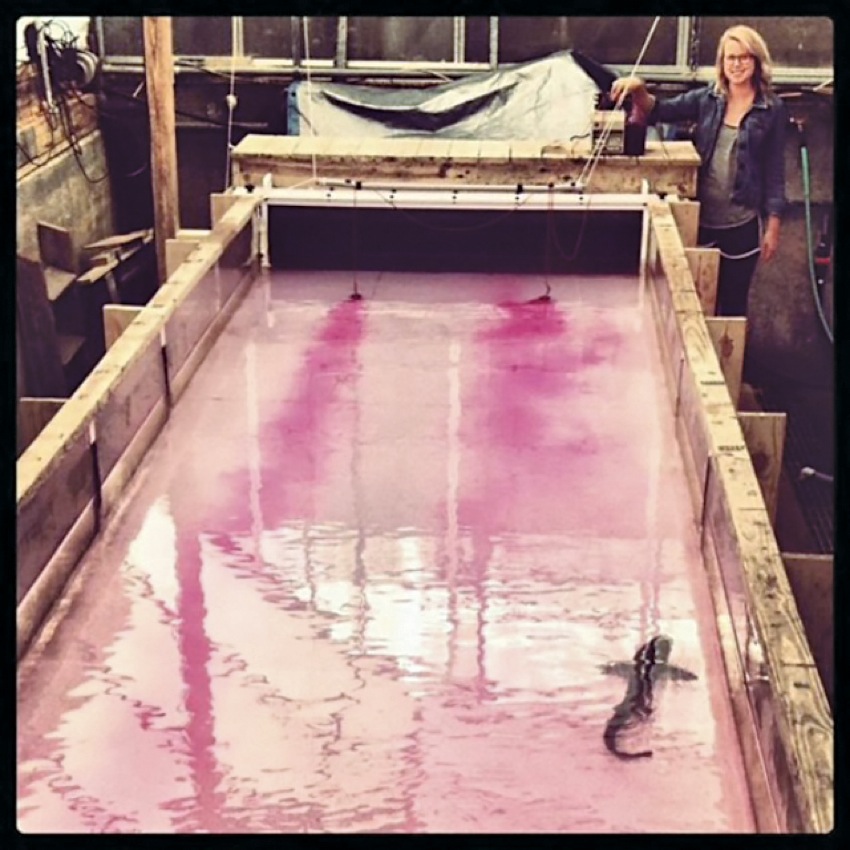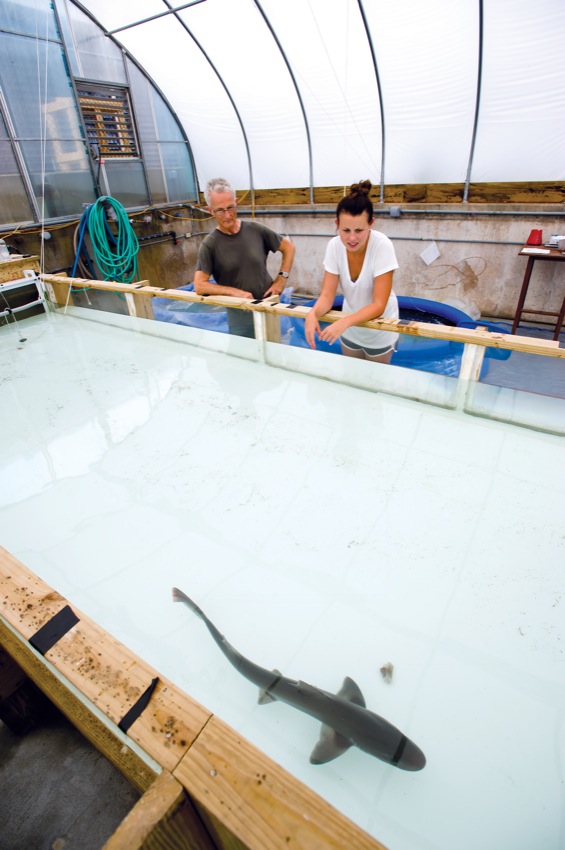Diving in

What would it be like to be a shark?
Maybe you’re picturing rows of ragged sawteeth and remembering the last time your stomach growled at you. Or perhaps you’re imagining the feeling of cool water on a strong, streamlined body, and wondering what it would be like to have a superhuman sense of smell.
Most people really wouldn’t even know where to begin imagining. But this question lights up Ashley Jennings’s face. “I think about that pretty much every day,” she says.
Jennings, who graduated from Wheaton College in 2007, explored this question in her research at Boston University, where last year she completed a master’s degree in marine/sensory biology. Working with Jelle Atema, a professor of biology at Boston University and adjunct scientist at Woods Hole Oceanographic Institution (WHOI), Jennings spent three summers at WHOI studying smooth dogfish, small sharks that can be found along the coast of Massachusetts, for her master’s thesis. While urban legend tells us that a shark can smell a drop of blood in an Olympic-sized swimming pool, Jennings hopes that her research on sharks’ sense of smell will help to dispel that myth, as well as our overblown fear of these animals.
Jennings, who now is a lab supervisor in the Biology Department at BU, has been studying sharks since her days at Wheaton, where she majored in biology and minored in chemistry. Initially considering veterinary medicine, she became hooked on sharks during an animal husbandry internship at Chicago’s Shedd Aquarium, where her animal-husbandry tasks included handling sharks for medical exams. Returning to Wheaton, Jennings had the opportunity to pursue her first research project on sharks. She and Professor of Biology Sean McCafferty traveled to a lab at Woods Hole to collect DNA samples from mother sharks and their litters, and studied the sharks’ genetics back on campus.

“A mother shark can hold different litters of pups with multiple paternities, and so we looked at genetic differences throughout these different litters,” Jennings says. “On a very basic level, it was an opportunity for me to learn lab techniques in molecular biology, but it was based around a topic I was interested in, so that made it a lot of fun.”
Encouraged by her work with McCafferty, she went on to intern at the Florida Program for Shark Research, where she worked with a Ph.D. student to study the vertebrae (spinal bones) of hammerhead sharks to determine their ages. She also had the opportunity to tag wild rays, a group of fishes closely related to sharks, to track their movements in the ocean.
Although she had loved studying sharks, Jennings wasn’t entirely sure after graduating that she wanted a career in scientific research. She spent a few years trying out different interests, working as a field manager for Environment Illinois, an environmental advocacy organization, and using her background in chemistry as a laboratory manager at a materials engineering lab. Prior to attending Boston University, she earned a master’s degree in environmental management at Northwestern University, and even considered a career in environmental law.
In 2011, she decided to pursue the master’s degree in marine biology at BU, which led her back to the water.
“I had a professor at Boston University who told me that you have two choices as a researcher,” Jennings says. “You can either choose an organism and then find a project that fits that organism, or you can choose a problem and find an organism that helps you solve that problem.” Jennings went the first route: since discovering her fascination for sharks, she has jumped into a great variety of research projects, studying everything from genetics to senses and behavior.
To study sharks in the lab at WHOI, Jennings and Atema used a 30-foot-long aquarium tank called a flume, which is specially designed for odor sensory experiment. At one end was a holding chamber where a small shark waited to be released. At the other end of the tank, the scientists used tubes to release two squirts of water, both dyed so that they could see the plume traveling through the tank. One plume would have a smell—a diluted smoothie of freshly blended squid—while the other had no scent. This gave the shark a choice: both plumes create some turbulence in the water, but only one of them has a scent. If the shark followed the plume with the squid smell, Jennings rewarded it at the end with a little bite of squid attached to the end of a dowel. Changing the amount of squid smoothie in the scented plume allowed Jennings to pinpoint when the squid smell was too faint for the shark to follow. To make sure the sharks weren’t just choosing the same side each time, the sharks were tested three times: once with two unscented plumes, once with scent to the left, and once with scent to the right.
“I could dilute the squid mixture between four and five log steps [log steps are factors of 10] and the sharks could track the smell to the source,” Jennings says. “So sharks have a very sensitive smelling system, but it’s probably not as sensitive as a drop of blood in an Olympic-sized swimming pool. Especially if there is no turbulence: It is a combination of flow and odor that leads to tracking.”
Sharks have other sensory systems that mammals do not share. Special cells, called ampullae of Lorenzini, detect the slight electricity of other animals’ muscle movements, and all fish also have a system of sensory cells, called lateral lines, which they use to sense water movement along their body.
“That’s how schooling fish school so efficiently,” Jennings says. “If their neighbor’s body is pushing water one way, then the fish’s lateral line will be able to feel that.”
“There’s something fantastic about doing science the way some people do art: just for the sake of figuring it out or creating something awesome,” Jennings says.

But, of course, there are practical applications, too. “Learning how these animals track food, as the apex predators that they are—and as threatened as they are—could give us more knowledge to aid their conservation.”
While Jennings is attached to her miniature sharks, sharks generally aren’t known for being cuddly. Their bad reputation is damaging not just for sharks, but also for marine ecosystems around the world. A recent estimate suggests that humans kill at least 100 million sharks a year.
“If we continue at this rate, we’re going to reduce shark populations. If they have a hard time with the changing climate, then it’s reasonable to predict that something is going to shift within the ecosystem,” Jennings says. She believes that a better understanding of these animals can help to remove stigma and motivate people to protect them.
In a project prior to her thesis, Jennings participated in a similarly designed experiment to investigate how climate change might affect sharks’ ability to smell and hunt for prey. The resulting paper, authored with Danielle Dixson, Jelle Atema and Philip Munday, was published in the journal Global Change Biology in August 2014, and was highlighted in a September 2014 article in the New York Times titled “On the Cusp of Climate Change.”
When carbon dioxide from the atmosphere is absorbed into the ocean, a chemical reaction occurs that makes the water more acidic. This is known as ocean acidification, a process that is already changing the chemistry of seawater around the world. Jennings found that higher levels of carbon dioxide in the water, including the level predicted for the year 2100, severely impaired the sharks’ ability to smell and follow the odored plumes.
Jennings explains, “The more acidic the water is, the fewer sensory capabilities the sharks have, and if you remove an apex predator from an ecosystem—for example, if it’s not motivated to hunt and catch food—then you’re really affecting an entire ecosystem. Understanding how an animal does something can lead to potential applications for conservation in the future.”
This past fall, Jennings began a teaching position at Boston University as supervisor for all introductory biology labs, a role that evolved out of her teaching fellowship as a graduate student. Refreshing the curriculum to keep up with the pace of current research—and to inspire students who are just beginning to study science in college—is a rewarding new challenge.
She graduated from a large high school system in Chicago. “It was one of the biggest high schools in the region, and that was a little disenchanting,” she explains. That background was part of why she chose the more personalized experience of Wheaton, and it has also motivated her to work with urban-outreach programs that bring high school classes from Boston into labs at Boston University. The high school students have the opportunity to work with faculty, undergrads and graduate students as they study ecology in a patch of forest in the city or simulate the outbreak of a pathogen in the classroom.
“A lot of these urban high schools have a very low college application rate,” she says. “Hopefully, this experience will inspire some kids to go to college, to make them think that the possibility of going to college is realistic.”
Jennings’s grandmother, Bojan Jennings, taught chemistry at Wheaton for four decades, and so Wheaton was at the top of Ashley’s list when she was thinking about colleges. Although her family’s deep connection to the school was encouraging, it was not the sole deciding factor. She remembers being hooked by a conversation with Professor of Chemistry Elita Pastra-Landis, who painted a picture of what to expect from an experience at Wheaton: dedicated mentors, small classes and an emphasis on interdisciplinary thinking.
Pastra-Landis herself attended Wheaton and studied chemistry with Ashley’s grandmother. She recalls, “Arriving in September of 1965 from Greece, not yet 18, I might have become lost in the strangeness of this new country had it not been for Bojan Jennings. She immediately took me under her wing. Bojan set the example for the kind of teacher that I wanted to become: available to my students, happy to give any assistance, but also demanding in academic matters.”
Ashley took a year of organic chemistry with Pastra-Landis toward her minor, which gave the professor an opportunity to really get to know her as a student and as a person. Pastra-Landis became such a mentor for Ashley, even encouraging her to become scuba-certified so that she could dive into the marine world she was studying. After her graduation, the newly scuba-certified Jennings met up with Pastra-Landis, a veteran diver, for a diving trip off the Caribbean island of Bonaire.
“I am delighted that she is working in the field of science education,” says Pastra-Landis. “Just like her grandmother, when an idea or a new description of the biological world excites her, Ashley is the most enthusiastic teacher imaginable.”
So far, Jennings hasn’t used her scuba-diving skills for her marine research, but she has logged more than 30 hours underwater in beautiful spots all over the world. One of her most memorable dives took her to the Red Sea in Egypt.
“There were all these little orange fish with long tails called anthias and there were thousands of them swimming around huge sponge mounds. It was a marvel—like seeing a huge flock of birds fly over you.”
Jennings didn’t discover sharks until college, but she always knew that she wanted to study marine biology. As a child, the highlight of her summers was exploring tide pools near her grandparents’ coastal home in Plymouth, Mass. Her parents like to show off photos of little Ashley with goggles on, lying face down on the sand, peering into tide pools.
“My cousins and I would go down to the beach and every time there was a low tide, a sandbar was exposed,” she remembers. “A lot of critters got left behind and so we would make what we called ‘starfish colonies.’ We’d go pick up all the crabs and starfish and snails and we’d plop them in a tide pool. We thought we were saving all the animals, when in reality we were probably giving the crabs and seagulls dinner.”
It’s easy to see why Jennings has developed a fascination for the underwater experience of sharks. The discoveries made in a tide pool, a coral reef, or a biology lab are not just vital for marine conservation—they can also fill a lifetime with a childlike curiosity and awe.
